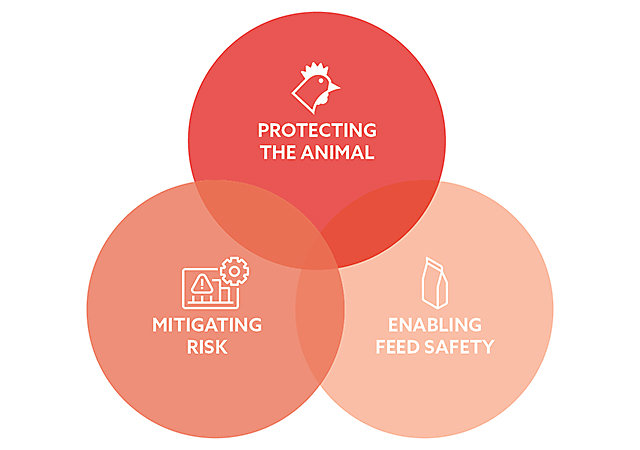Mycotoxins can contaminate almost all agricultural ingredients and this is the reason why we believe it’s so important to control them. Even the smallest instance of mycotoxins can impair a pig’s intestinal health, immune function, and/or pathogen fitness, resulting in altered host-pathogen interactions and therefore a higher susceptibility to disease. Moreover, mycotoxins can impact the effectiveness of vaccinations and can also lead to a range of pathological problems i.e. toxicity in the liver and kidney as well as estrogenic responses which are very problematic for sows and their piglets. In turn, all of this, unfortunately, leads to productivity losses.
It’s important to know that feeding pigs a Fusarium (T-2, DON) mycotoxin-contaminated diet increases the susceptibility to salmonella. The pathogenicity of E. Coli, ETEC, as well as SEPEC, in pigs is increased when pigs are fed a mycotoxin-contaminated diet. Respiratory disease in pigs is often caused by the combined effects of a range of pathogens and predisposing factors. For instance, one predisposing factor is fumonisins — well-known for causing pulmonary edema in pigs and this may consequently facilitate M. hyopneumoniae infection, a primary pathogen resulting in respiratory diseases in pigs.
Further to this, mycotoxins promote the incidence of PRRS (Porcine Reproductive and Respiratory Syndrome) — one of the most challenging problems for farms since it significantly impacts a pig’s productivity in comparison to other syndromes. What is more, is that the exposure of piglets to fumonisins increases their risk for PRRSV disease.
Sadly, our research has shown an underestimation of mycotoxins due to:
- Incorrect sampling due to the occurrence of hotspots;
- Masked mycotoxins — mycotoxins bound to components in feed, such as sugars, escape analyzes but remain toxic to the animal;
- Emerging mycotoxins are not routinely analyzed, in particular, those found in silages.
Learn more about Mycotoxin Management in our digital brochure






